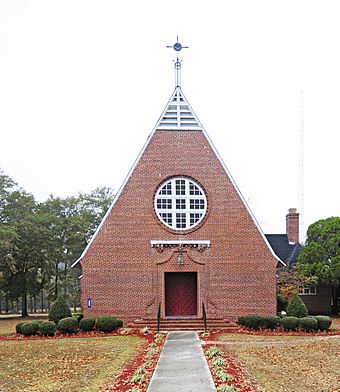Voorhees College Historic District facts for kids
The Voorhees College Historic District is a special area that includes the campus of Voorhees College in Denmark, South Carolina. It's a place recognized for its history. Thirteen of the buildings on campus are considered "contributing properties." This means they help tell the story of the district's past.
Voorhees College was started by a remarkable woman named Elizabeth Evelyn Wright. She named it the Denmark Industrial School. Her goal was to create a school like the Tuskegee Institute, where she had studied. Wright stayed in close contact with her mentor, Booker T. Washington. The school was a big effort in the late 1800s to give education to African-American children in a rural area who didn't have many opportunities. Over time, the school grew. It became a normal school (which trained teachers) and then a four-year college.
Quick facts for kids |
|
|
Voorhees College Historic District
|
|

St. Philip's Episcopal Church
|
|
| Lua error in Module:Location_map at line 420: attempt to index field 'wikibase' (a nil value). | |
| Nearest city | Denmark, South Carolina |
|---|---|
| Area | 40 acres (16 ha) |
| Built | 1897, 1904–1935 |
| NRHP reference No. | 82003830 |
| Added to NRHP | January 21, 1982 |
Contents
Why Voorhees College is Important
This historic district is special for a few reasons. The buildings show off advanced architectural styles for an African-American college in the early 1900s. Many of these buildings were even built by the students themselves! The college was also a leader in African-American education. It is strongly connected to its amazing founder, Elizabeth Evelyn Wright.
On January 21, 1982, the Voorhees College Historic District was added to the National Register of Historic Places. This is a list of places in the United States that are important to history.
Key Buildings and Their Stories
Several buildings in the district are very important because of their history or how they were built. Here are some of them:
Booker T. Washington Hall
- Booker T. Washington Hall is a brick building. It was built in 1905. It first served as a hospital for the college.
Blanton Hall
- Blanton Hall is a two-and-a-half-story brick building. It was built in 1914. This building was originally used for administration. Today, it holds offices for staff and classrooms for students.
Menafee Trades Building
- The Menafee Trades Building is a two-story brick building. It was built in 1907. This building was made possible by a gift from Ralph Voorhees. It was first known as the Boys Trade building. It was later named after Martin Menafee. He was the college's treasurer and the husband of the founder, Elizabeth Wright.
St. Philip's Episcopal Chapel
- St. Philip's Episcopal Chapel is a brick chapel. It was built in 1935. You can see a picture of it in the infobox at the top of this article.
Elizabeth Evelyn Wright's Grave
- The grave site and tombstone of Elizabeth Evelyn Wright are also part of this historic district. It's a way to remember the college's founder.
Bedford Hall
- Bedford Hall is another brick building. It was built in 1912. It was named for R.C. Bedford. He was a member of the college's first Board of Trustees. He also helped Booker T. Washington.

